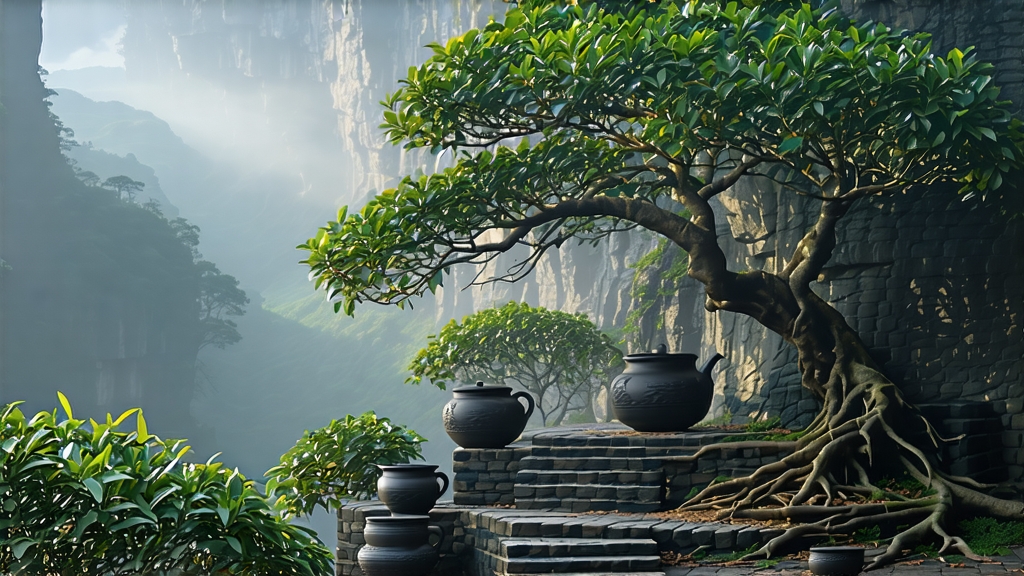
High in the UNESCO-listed Wuyi Mountains of northern Fujian, narrow bamboo rafts glide between sheer granite cliffs whose crevices cradle one of China’s most storied oolongs—Shui Xian, literally “Water Immortal.” To international drinkers the name may sound romantic yet vague, but within Chinese tea circles it signals a cultivar, a micro-terroir, and a centuries-old craft tradition that turns partially oxidized leaf into a liquor tasting of orchid, roasted peach, wet stone, and something locals mysteriously call yan yun—“rock rhyme.” This essay invites you to meet Shui Xian on its own terms: its mythic birth, the garden ecology that shapes it, the laborious charcoal roasting that tames it, and the gongfu ritual that coaxes its quiet power into your cup.
Myth and Migration
Legend places Shui Xian’s origin near the banks of the Min River during the Song dynasty, when a drought-plagued village offered prayers to a Taoist water goddess. A wandering monk dreamt that the goddess pointed to a lone tea tree whose leaves perfumed the air even before processing. Cuttings were taken to the Wuyi cliffs, where monks discovered that the strain thrived in mineral-rich, shallow soils wedged between rocks. Historical records are drier but no less fascinating: by the early Qing, Shui Xian had become a tribute tea, shipped north along the “Tea Road” to Russia via the port of Xiamen. The name thus fuses folk religion with geographic destiny—an immortal of water transplanted onto stone.
Terroir: Gardens Suspended in Sky
Wuyi’s Danxia landform creates a labyrinth of narrow gorges whose red sandstone weathers into gravelly, fast-draining terraces. Shui Xian bushes are trained into single-trunk, umbrella-shaped trees rather than the low hedges seen in Anxi or Taiwan. Some mother trees exceed five meters in height and are over three hundred years old, their gnarled roots gripping fissures that drip with moss-filtered spring water. Morning mists slow photosynthesis, concentrating amino acids, while cool nights lock in floral aromatics. The result is a leaf that carries the literal taste of stone—an electric, mouth-watering minerality impossible to replicate at lower elevations.
Craft: The Nine-Step Transformation
Plucking begins in late April when three leaves and a bud reach the “small open face” stage—still tender but firm enough to withstand the rigorous handling ahead. Leaves are spread on bamboo trays to wither under natural mountain breeze, losing about 10 % moisture and acquiring a grassy sweetness. Next comes yao qing, “rocking green,” a unique bruising technique: 20-kilogram batches are tossed inside a cylindrical bamboo drum that rotates just fast enough to crack cell walls without macerating the leaf. Oxidation proceeds in climate-controlled rooms kept at 24 °C and 75 % humidity; master tea makers interrupt the enzymatic browning every hour by sniffing—when the aroma shifts from lily to ripe peach they slam on the brakes. A 280 °C tumble-roast for seven minutes kills greenness and sets the floral note.
What distinguishes Wuyi Shui Xian from other oolongs is its two-stage charcoal roasting. First, the maocha is given a “foot fire” at 120 °C for two hours to drop residual moisture to 5 %. After a month of resting, leaf is re-roasted in small batches inside reed baskets lined with local horse-dung charcoal (odorless, high carbon). Temperature is lowered by 10 °C every subsequent roast; a premium Shui Xian may receive up to five cycles across half a year. Between firings the tea hibernates in earthenware jars, allowing moisture to migrate from stem to leaf, equalizing flavor. The final roast imparts a whisper of ember and caramel that frames, rather than masks, the cultivar’s natural orchid aroma.
Grades and Styles
Western vendors often label any dark, roasted Wuyi oolong as “Shui Xian,” but Chinese traders distinguish at least four grades. “Common garden” Shui Xian grows on terraced hillsides below 300 m; it is roasted once and sells for café blending. “Cliff garden” (ban yan) leaf originates from the scenic area’s buffer zone; two roasts yield balanced body. “Zheng yan